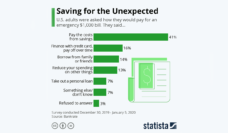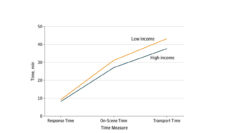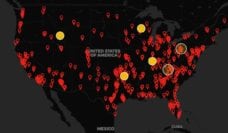Distance matters. Health inequities can arise from the differences in who has access to the best care, and that can mean how difficult such care is to reach. Some people must travel five or more miles to get to a level one or level two trauma center. This means that some might not be able to reach emergency care when they most need it. These distances are especially important for patients with gunshot wounds. Many will die on the way to emergency care or soon after arrival if they are further than five miles from trauma centers.
The maps above show how access to trauma care differs across Chicago, Los Angeles, and New York City. Researchers wanted to know who lives in low (orange) and high (blue) trauma care access areas. Using data from the 2015 American Community Survey, they classified neighborhoods by race and mapped distances to trauma centers.
In New York City and Los Angeles, neighborhoods with predominantly Hispanic or Latino populations had the greatest access to trauma care. However, in Chicago, these neighborhoods were the least likely to have access. Neighborhoods with predominately Black populations were less likely than neighborhoods with predominately White populations to be within five miles of a trauma center in both Chicago and Los Angeles, but not in New York.
Low-access areas often corresponded with historically racially segregated neighborhoods. Broadly, Black Americans are therefore at a higher risk of failing to receive needed trauma care compared to Hispanics or Latinos and Whites. The researchers suggest that trauma care planning must carefully consider the needs of the historically underserved.
Databyte via Tung EL, Hampton DA, Kolak M, Rogers SO, Yang JP, Peek ME. Race/Ethnicity and Geographic Access to Urban Trauma Care. JAMA Netw Open. 2019;2(3):e190138.














